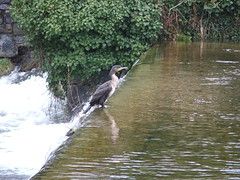Last Monday I was honoured to be chosen to present to a full meeting of the Galway City Council one of the most important local strategic policy of recent years. Commissioned by the Galway City Development Board (CDB), the 'Galway City Habitat Inventory' was produced by one of the country's top ecological outfits NATURA.
Its aim: to protect and enhance the natural areas within the city's boundaries where wild flora and fauna can live.
If the report's recommendations are implemented, the document could serve as a successful blueprint for biodiversity in other urban environments in Ireland and abroad.
Sadly, we have been waiting since February 2005 to meet the City Council on this report. In the interim, at least one of the sites earmarked for protection has been destroyed by a developer.
Actually, I never got the chance to speak as the report was deferred on the night to a Council meeting in mid May due to heavy discussion on the controversial Lackagh quarries.
Anyway, the document was the result of the combined efforts of a myriad of organisations and individuals involved in, or concerned with, wildlife and land/aquatic management including the government's Parks & Wildlife Service, Birdwatch Galway, Galway University, Galway City Council, Western Regional Fisheries Board and the OPW. There were also individual contributors such as the renowned naturist Gordon D'Arcy and Crann's Sasha van der Sleesen who have done much over the years to increase public awareness of the wildlife population of our urban jungle. As a community representative on the CDB, I played a role in having this action adopted as a key priority.
Its publication has come at a critical time in the city's history. There is ever-increasing pressure being forced onto the rural areas located within the city boundaries. Continuous high population growth is leading to more roads, residential & business developments devouring the last remnants of our natural landscapes. What are today's green fields will become tomorrow's concrete housing estates. Hence it is critical to ensure that land is allocated now for other species to exist and that links are developed to allow the free movement of wildlife between habitats. Without biodiversity, the survival of the human race itself will be threatened as all life forms on this planet are interconnected.
The report shows that Galway city still has a wonderful cornucopia of wildlife habitats including blanket bog, limestone pavement, turloughs, hedgerows, wetlands, muddy shores, salt marsh, sea cliffs etc. An amazing 58 kinds of habitats were identified with 22 considered to be nationally or internationally rare. The authors provide details on each habitat and any known threats to their survival. Most importantly, they give recommendations necessary to conserve these habitats that include.
o Designate any nationally or internationally important habitat as Special Area of Conservation (SAC) or National Heritage Area (NHA)
o Prepare a management plan for each of the designated habitats
o Protect and enhance 3 major ecological corridors or what the Americans call 'green highways' which directly connect a series of natural habitats into the neighbouring jurisdiction of Galway County.
o Hedgerows and stone walls should be retained were possible as part of ecological networks

No comments:
Post a Comment